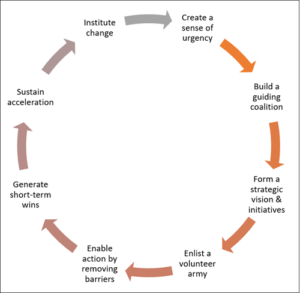Dennis Deery
Change is constant – we all deal with it, we all complain about it. We all do it. In a 2008 study titled “The Enterprise of the Future”, IBM surveyed over 1,000 CEOs around the world. 83% of those surveyed said they expect their organization to undergo substantial change.
But only 61% of those executives believe they have managed change successfully in the past.
Why the disconnect? If change is so constant, why are we so bad at it?
In short, we don’t deal with change intentionally. Because it’s constant, because we’re all facing a number of different changes all the time, we make the mistake of thinking that change is something that just happens. Change will just happen, but if you don’t plan for it and manage it effectively, it might not be the change you were expecting. Improperly handled, change can cause people to burn out, hurt morale, and eventually destroy organizations.
One way to better manage change is by using a change model – a framework that provides you with a definitive set of steps to apply to your unique change. This framework will help to ensure that you don’t miss anything important in your rush to get change done.
A good, basic change model is Lewin’s 3-Step Model, developed by German-American psychologist Kurt Lewin in 1947. Lewin’s model is widely considered the foundation for all modern change models, and is a good place to start in understanding the utility of change models.

As you can see, Lewin’s steps are Unfreeze, Change, and Refreeze. The unfreeze step consists of preparing for change – this usually involves getting buy-in from the people involved, defining a plan, and any other groundwork that must be laid. Change is the implementation step. Refreeze is the step that is all too often given short shrift in most organizations. After a change is complete, people need support and time to internalize the change. For example. a new business process may be taught to employees fairly quickly. However, if they’ve been using a different process for months or years, it will take time for them to become comfortable and fluent with the new process. Leading effective change requires that you consider how long it will take people to adapt to the change, and what supports you may need to provide them while they work through the change.
While Lewin’s model is a great starting point, you can see that it lacks detail about what should happen in each stage of change. There are dozens of models based on Lewin’s theory, but one we’re partial to is the 8-Step Process (be sure to download the free e-book at the link), developed by Harvard Business School professor John Kotter in 1995. The first thing you’ll notice is that Kotter’s model is represented as a cycle, rather than as a linear process. This fits better with our understanding that change is a constant process. Secondly, we believe Kotter’s model does a good job of identifying the steps needed to implement change successfully.

You can also see that Kotter’s model has change implementation very late in the process. If you take care to prepare and build small wins, the actual implementation of change can happen much more smoothly than if people are unprepared. Be ready though – proper preparation will take more time than you think it will!
Finally, pay attention to the fact that Kotter’s steps are largely people-focused. Motivated people with the right support will make change happen successfully. Focus on the people involved in your change and you’ll be off to a good start. Use a model to manage your change. You shouldn’t follow any model blindly – you’ll need to adapt any model to your specific change. But use the model to ensure that you don’t miss important components of any change.
Related
Take a Systems View
July 20, 2018
CommunityDevelopment OrganizationalDevelopment ProfessionalSmall Town Rules
May 8, 2012
Professsional CommunityDevelopment BooksBooks
Midwest Rural Assembly 2010
September 3, 2010
Professsional CommunityDevelopmentRural Issues